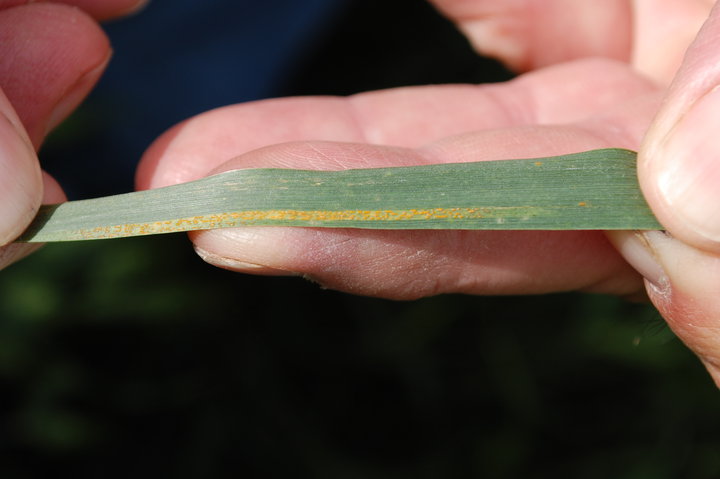
Agricultural News
Wheat Diseases Post 'Firsts in Oklahoma,' Bob Hunger Says
Fri, 12 Apr 2013 16:21:35 CDT

Dr. Bob Hunger, Oklahoma State University Extension Wheat Pathologist says a couple of firsts occurred this week in Oklahoma.
He says Southwest Area Extension Agronomist Mark Gregory reported the first leaf rust in Oklahoma for 2013. It was on Overley near Devol, Okla., which is near the Red River north of Wichita Falls, Texas. The wheat was at GS 10-10.1 (boot to heads just emerging), and was in a field with quite a bit of damage from the freeze. He says that from Mark's description, the prevalence was fairly low as he indicated he had to look around quite a bit to find rust pustules.
With the appearance of foliar diseases, Hunger says that he and Dr. Jeff Edwards have taken the opportunity to update "Foliar Fungicides and Wheat Production in Oklahoma - April, 2013" (OSU Current Report CR-7668). This publication provides answers to many of the common questions typically asked about wheat foliar fungicides and provides a table listing the most common fungicides available to control wheat foliar diseases.
The second first that Hunger reports is the first confirmed sample of wheat streak mosaic in Fuller wheat from southwestern Oklahoma near Sentinel in Washita County. This was in a field that had been sprayed for volunteer wheat last fall. He says that perhaps sufficient time was not allowed to elapse between the spraying of the volunteer and the planting of the wheat in the fall. He says two weeks should be allowed between the complete death (not the spraying) of volunteer wheat and the emergence of seedling wheat in order to kill the wheat curl mites that transmit wheat streak mosaic virus.
Hunger reports that his counterpart in Arkansas, Dr. Gene Milus from the University of Arkansas, just sent out an important message about being careful to not exceed the maximum amount of a fungicide applied to a crop in a single year.
Such a consideration could be an issue where more than one fungicide application is made. Milus said this is especially true if a generic of tebuconazole is applied, as this chemical also is in Prosaro; however, multiple applications of the same fungicide may also exceed the maximum amount of chemical that can be applied in a single year.
Reading the label is the best place to determine the maximum amount of a chemical that can be applied in a single season and the exact amount of a chemical(s) that is in a fungicide. A quick reference to what chemicals are in the typical fungicides used on wheat in Oklahoma is the OSU Current Report (CR-7668) that Dr. Jeff Edwards and I recently updated.
In Arkansas and many states through the mid-western region of the U.S., two or even three fungicide applications on wheat are more common, with the last application typically targeted toward Fusarium head blight (scab). In Oklahoma, where scab usually is not a concern, deciding to apply one fungicide application typically has been the only consideration. However, in recent years making two fungicide applications have become more common because of higher wheat prices, lower cost of fungicides, and increased no-till wheat acres that favor early diseases such as powdery mildew, tan spot, and septoria/stagonospora. It is in these situations that care must be taken to insure label compliance.
Given the early onset of stripe rust and the cool rainy weather in recent weeks, some wheat growers are considering two or three fungicide applications. This is a new phenomenon for Arkansas growers and requires some planning to stay within the legal limits for total amounts of particular fungicides that can be applied to wheat fields. The fungicide label lists to total amount of each active ingredient that can be applied per acre per year. These amounts usually are given in pounds of active ingredient (lb ai) which require some math to translate into fluid ounces (fl oz) of particular products. The total amounts and usual application rates below are for fungicides most likely to be used in Arkansas:
Tebuconazole: total amount = 0.11 lb ai/A = 4 fl oz/A.
Products containing only tebuconazole include Folicur (no longer being sold), Orius, Tebucon, Tebustar, Tebuzol, Tegrol, and Toledo.
Prosaro: total amount = 8.2 fl oz /A = 0.11 lb ai each of prothioconazole and tebuconazole.
(Note that no Prosaro can be applied if 4 fl oz of a tebuconazole product was applied earlier because Prosaro is half tebuconazole.)
Propiconazole: total amount = 0.22 lb ai/A = 8 fl oz/A.
4 fl oz/A = 0.11 lb propiconazole.
Products containing propiconazole include Tilt, Bumper, Fitness, Propiconazole E-AG, and PropiMax
Quilt Excel: total amount = 28 fl oz/A = 0.22 lb propiconazole + 0.26 lb azoxystrobin
14 fl oz Quilt Excel = 0.11 lb propiconazole + 0.13 lb azoxystrobin.
(Therefore 4 fl oz of a propiconazole product + 14 fl oz of Quilt Excel can be legally applied.)
Pyraclostrobin (Headline): total amount = 18 fl oz/A = 0.29 lb ai/A
9 fl oz = 0.147 lb Pyraclostrobin (Note the slight discrepancy between the total amounts expressed as fl oz/A and lb ai/A.)
Metconazole (Caramba): total amount = 34 fl oz/A = 0.20 lb ai/A
17 fl oz = 0.10 lb Metconazole
Twinline: total amount = 18 fl oz/A = 0.10 lb metconazole + 0.15 lb pyraclostrobin
9 fl oz/A = 0.05 lb metconazole + 0.076 lb pyraclostrobin
(Note the discrepancies for total amounts metconazole and pyraclostrobin depending on which products are used.)
WebReadyTM Powered by WireReady® NSI
Top Agricultural News
More Headlines...




















